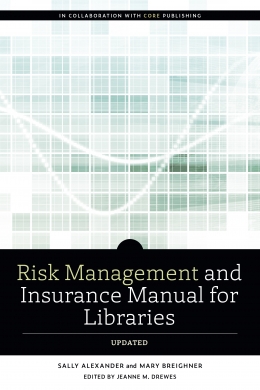Primary tabs
You don't need to be an ALA Member to purchase from the ALA Store, but you'll be asked to create an online account/profile during checkout to proceed. This Web Account is for both Members and non-Members. Note that your ALA Member discount will be applied at the final step of the checkout process.
If you are Tax-Exempt, please verify that your account is currently set up as exempt before placing your order, as our new fulfillment center will need current documentation. Learn how to verify here.
- Description
- Table of Contents
- About the authors
Amidst uncertain times rife with challenges and potential catastrophes, prudently managing risk will bolster your library’s resilience in the face of adversity. And by being attentive to lowering risk, you’ll help keep insurance costs in check. This succinct manual for trustees and administrators offers straightforward guidance for designing and implementing a library risk management program. You’ll get succinct advice on such essentials as
- the five major areas of risk and loss for libraries, with an overview of the types of property and casualty coverage common to most libraries;
- how to determine if the new framework of enterprise risk management is right for your library;
- elements of a good risk policy statement;
- tips for determining the value of your collection, plus a sample risk assessment template;
- the most library-relevant portions of the National Fire Code;
- insurance considerations for remodeling or construction projects;
- advice on cybersecurity and handling cyberattacks;
- setting up an emergency response team that is ready when disaster threatens;
- developing a financial plan that assures uninterrupted service despite adverse conditions; and
- guidance on the paperwork a claims adjuster will require.
This to-the-point resource will lead you onto the best path to safeguarding your library’s assets and future.
Preface and Editor’s Note
Introduction
Chapter 1: A Risk Management Philosophy for Libraries
Chapter 2: Risk Identification
Chapter 3: Risk Quantification and Evaluation
Chapter 4: Loss Prevention
Chapter 5: Risk Financing
Chapter 6: Risk Financing—Insurance
Chapter 7: New Construction
Chapter 8: Claims
Bibliography
Appendixes
- Appendix A: Risk Management and Insurance Resources
- Appendix B: Sample Risk Management and Insurance Policy
- Appendix C: Risk Assessment Template
- Appendix D: Suggested Guidelines in Museum Security
- Appendix E: Property Loss Prevention Checklist
- Appendix F: Library Safety Inspection Checklist
- Appendix G: Contingency Planning for Natural Disasters
- Appendix H: Sample Request for Proposal—Insurance Brokerage Services
About the Authors
Index
Sally Alexander
Sally Alexander serves as director of risk management and chief risk officer for Colorado State University (CSU). She manages the operations of the Office of Risk Management and Insurance (RMI) and leads institutional risk management efforts on campus. She served on the board of directors of the University Risk Management and Insurance Association (URMIA) from 2013 to 2017 and co-chaired URMIA’s Governmental Regulatory Affairs Committee during that same period. She has co-presented at various URMIA conferences and sessions. In 2019 she was awarded CSU’s Office of International Programs’ Distinguished Service Award in recognition of outstanding contributions to the internationalization of CSU. Prior to joining CSU in 2008 she worked for Larimer County as a risk manager. Originally from South Africa, she practiced law in the field of insurance law. She has a BA degree from the University of Witwatersrand, Johannesburg, South Africa; an LLB (bachelor of laws) degree from Rhodes University, Grahamstown, South Africa; and a master’s degree in environmental policy and management from the University of Denver, Colorado. She also has an associate’s degree in risk management and a master’s of business administration from CSU.
Mary Breighner
Mary Breighner is a chartered property and casualty underwriter (CPCU). She was formerly the vice president and global practice leader for FM Global, where she oversaw and guided the accounts and account servicing of more than 300 colleges and universities, as well as hundreds of public schools, governmental entities, and hospitals worldwide. She remains an active member of the University Risk Management and Insurance Association (URMIA) and has served on various committees there, as an officer, director, and past president. She received the Distinguished Risk Manager Award from URMIA in 1992. In 2003 she became an affiliate member of URMIA’s board of directors. Breighner holds the CPCU designation. She has presented nationally and internationally on higher education and public entity risk management and insurance issues at numerous national and regional conferences. She coauthored the 2005 edition of this book and has published numerous articles in URMIA Journal.
Jeanne M. Drewes
Jeanne M. Drewes was chief of the Binding and Collections Care Section of the Preservation Directorate at the Library of Congress from 2006 to 2019 and is currently a cultural heritage consultant. Formerly, she was assistant director for access and preservation at Michigan State University Libraries and was head of the Preservation Department of the Milton S. Eisenhower Library at Johns Hopkins University. Drewes received the Ross Atkinson Lifetime Achievement Award in 2017. She received her MALS degree from the University of Missouri–Columbia and was a Mellon Intern for Preservation Administration at the University of Michigan. She is an active member of ALA, the American Institute for Conservation, the International Federation of Library Associations and Institutions, and the Guild of Bookworkers. For forty years, Drewes has taught workshops and published on the topics of insurance and risk management, disaster planning, preservation outreach, and other areas of preservation. She was the managing editor for the 2005 edition of this book.
Core
The former Association for Library Collections and Technical Services (ALCTS), the Library Information Technology Association (LITA), and the Library Leadership and Management Association (LLAMA) are now Core: Leadership, Infrastructure, Futures, a new division of ALA. Its mission is to cultivate and amplify the collective expertise of library workers in core functions through community building, advocacy, and learning.



